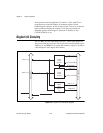
Chapter 3 Theory of Operation
AT-MIO-16X User Manual 3-18
©
National Instruments Corporation
AT-MIO-16X board can be recalibrated without external hardware at
any time under any number of different operating conditions in order to
remove errors caused by temperature drift and time. The AT-MIO-16X
is factory calibrated in both unipolar and bipolar modes, and these
values are also permanently stored in the EEPROM. Calibration
constants can be read from the EEPROM then written to the calibration
DACs that adjust offset and gain errors associated with each analog
output channel. For each DAC channel, there is an 8-bit offset
calibration DAC, and an 8-bit gain calibration DAC. Functions are
provided with the board to calibrate the analog output section, access
the EEPROM on the board, and write to the calibration DACs. To
calibrate an analog output channel, the appropriate DAC signal must be
wrapped back to the analog input circuitry. When the AT-MIO-16X
leaves the factory, locations 96 through 127 of the EEPROM are
protected and cannot be modified. Locations 0 through 95 are
unprotected and can be used to store alternate calibration constants for
the differing conditions under which the board is used. Refer to
Chapter 6, Calibration Procedures, for additional calibration
information.
DAC Waveform Circuitry and Timing
There are primarily two modes under which the DACs in the analog
output section operate: immediate update and posted update. Immediate
update mode is self-evident. You write a value to the DAC and its
voltage is immediately available at the output. In posted update mode,
the voltage is not available at the output until a timer trigger signal
initiates an update. This mode has advantages in waveform generation
applications which need precisely timed updates that are not
software-dependent.
DAC Waveform Circuitry
Figure 3-10 depicts the three different data paths to the analog output
DACs.


















